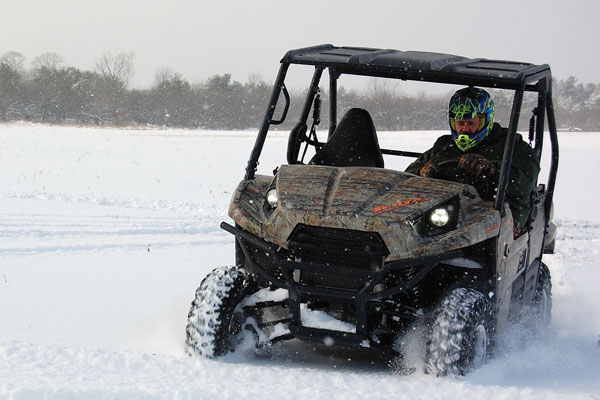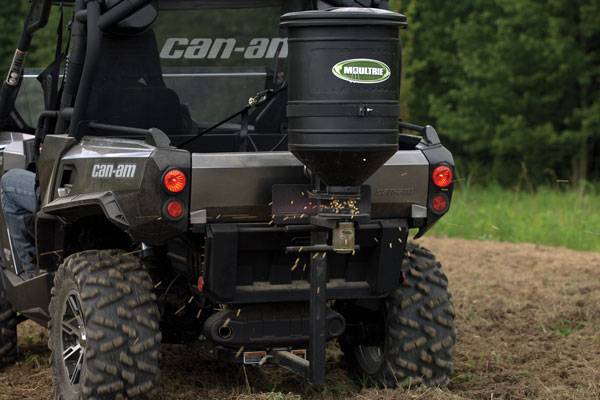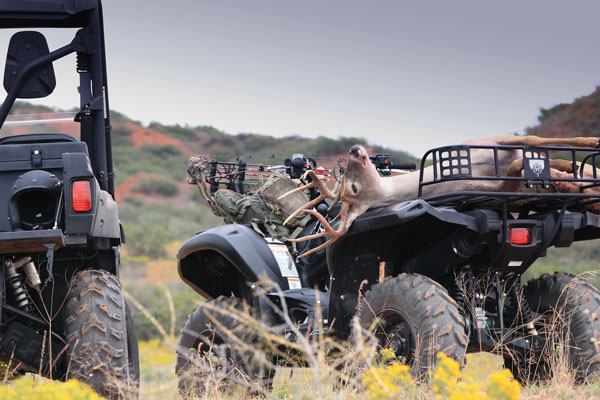November 04, 2014
By Derrek Sigler
 As deer hunters, we're bombarded with new products that promise to make our lives better. Perhaps this sea of options is a blessing . . . perhaps it's a curse. That's for you to decide. Regardless, it can complicate the matter of making a purchasing decision.
As deer hunters, we're bombarded with new products that promise to make our lives better. Perhaps this sea of options is a blessing . . . perhaps it's a curse. That's for you to decide. Regardless, it can complicate the matter of making a purchasing decision.
How many brands and models of compound bows can you find in just one sporting goods store? Which one's best? Post that question on a social media platform and see how many varied responses you get.
Off-road vehicles certainly fall into the category of hotly debated "hunting" equipment. Picking the best one for your needs is a matter of choice, and any number of them probably will get the job done.
But there are a few things to consider for making your decision easier.
Advertisement
ATV or UTV?
The first question is, which general type of vehicle do you want? ATVs, or 4-wheelers, are usually designed for a single operator. Some do have the capacity for carrying a passenger too, but you sacrifice cargo capacity. UTVs, or side-by-sides, offer more cargo and towing capacity, as well as passenger-carrying capability. They also tend to carry higher price tags, as well as being bigger and heavier.
 Ah, there's that word: price. Picking an ATV or UTV is kind of like picking a new bow. You have to decide if the features and performance you want fit into the budget you can swing. And as with selecting a new bow, you might find you can do just fine with a lower-priced model.
Ah, there's that word: price. Picking an ATV or UTV is kind of like picking a new bow. You have to decide if the features and performance you want fit into the budget you can swing. And as with selecting a new bow, you might find you can do just fine with a lower-priced model.
Advertisement
Some ATV and UTV companies have started doing something similar to what certain archery manufacturers have found popular with customers: They take a higher-end model, dial down some of the components and create a lower-priced machine. Can-Am, for example, recently released a slightly scaled-back version of its flagship Outlander ATV with the new Outlander L series.
It has a slightly different frame design, as well as lower-end suspension and tires. The result is a machine with the look and feel of the higher-end series but at a lower price.
What are you going to use it for?
That's the big question, and one you really need to answer before you buy. I will say, however, that you'll find uses you never thought you'd need a machine for. It happens to me all the time, and I've been using them for more than 30 years.
There are UTVs designed for a lot of different uses. Some of these machines bridge the gap between categories well — others, not so much. If your need is overwhelmingly for a machine that will haul heavy loads, units of a more utilitarian nature, such as Kawasaki's Mule or machines in the Kubota line, are great options to look into. But as a deer hunter, you're not going to be just sitting around the farm with it, right? You're going to haul and set stands, build and maintain food plots and more. You want to get out there.
That's what most UTVs are designed to help you do. These include the Polaris Ranger, the Kawasaki Teryx or Mule Pro FXT, Yamaha Viking, Can Am Commander, John Deere Gator, Arctic Cat Prowler and Honda Pioneer. Whew! That's a lot of choices — and I didn't even include the whole list. These machines have more and better suspension, higher top speeds and handling, and ride characteristics that are fun as well as functional.
Higher-performance machines, including the Polaris RzR line, Arctic Cat Wildcats and Can Am Mavericks, are all tons of fun to drive. But they're not designed for work in any real capacity. That said, as a hunter you still could use them in some way: namely, to get to your blind in a hurry.
On the ATV side, the biggest share of the market is devoted to utility-type machines. You have a plethora of options in machines with 4-wheel drive, racks and enough suspension to absorb most trail obstacles. ATVs are narrower than most UTVs, so they can fit into places the latter can't. The downside is that you're really limited as to the cargo you can haul.
A Word on Engine Size
Most adult-sized machines have engines ranging from around 300 cubic centimeters (cc) of displacement all the way up to 1000cc. Of course, the bigger the engine, the more power it tends to produce. And in most cases, the bigger its price tag.
An ORV dealer friend and I once were having a discussion on this topic. He said that for running a "plow" — either a dirt plow or a snow plow — the minimum engine size one should look at is 500cc. Below that, he told me, more of the machines come in for repairs. Serious habitat work can put a lot of strain on an ORV.
My father-in-law was set to buy a UTV and had planned on a 500-class machine. He then tried out several and chose a Polaris Ranger 900XP, which is far more powerful. He's been very happy with his choice. You might not ever need all of the horses you have, but it's better than finding you need horses you didn't buy.
The bigger then engine, the less it has to work to get the job done.
EPS & You
Electronic power steering (EPS) is a common feature these days. However, you'll find many machines available with a non-EPS option for a slightly lower price. As a hunter who spends a lot of time riding ATVs in the woods, I say opt for EPS if your budget allows — not only for your comfort but also for your safety.
What EPS of course does is help with steering. At higher speeds you don't need that much assistance, but at lower speeds a 1,200-pound machine can be a handful to keep pointed the right way. And safety really comes into play when you're trying to negotiate rocks, logs and other obstacles littering the terrain.
If you hit a fallen tree or other object on a non-EPS machine, the wheel or handlebars can be jerked from your grip; the tires turn sharply, and you can more easily have an accident. EPS absorbs the impact and keeps the shock from reaching you, as well as keeping the machine more on track.
One of the major complaints about EPS has been that it takes away too much feel from the rider, causing a slight disconnect between operator and machine (and machine, in turn, from land). But that concern isn't as valid as it once was. Companies such as Yamaha and Kawasaki have spent a lot of time engineering EPS systems that transfer enough feel to the operator. Some other manufacturers have caught on, too.
Noise Pollution
Engine placement plays a big role in how much engine noise you hear. Some machines, such as the Kawasaki Teryx, have centrally located engines. It's part of the design to keep the machine stable and centered in the most extreme terrain. The design is what makes the Teryx a favorite of those who look for the more intense places to travel, but it's also a bit louder to the operator's ears.
Meanwhile, rear-mounted engines, including those found in the Yamaha Viking or Polaris Ranger lines, offer a quieter ride and a center of gravity tuned to handle heavy payloads and towing.
One other note on noise: If you buy a UTV and plan to install a full-cab enclosure, be prepared to find doing so increases the interior noise level.
Driving vs. Riding
With steering wheels, seat belts and doors, UTVs have the same basic feel as your truck does when it comes to driving. The most important things to learn are how to handle turns, make elevation changes and keep the machine on four wheels.
Most of this you of course already know from driving an automobile. Accidents can and do happen. You've noticed UTVs come with roll cages, right? You don't want to test that feature, though.
ATVs require much more rider input. Your body position influences the handling to a great extent, and you should be ready to stand, lean and even step off quickly if need be. Bad knees and backs can influence decisions on vehicle type.
Making Your Choice
ATVs and UTVs are amazing machines that can help you put in food plots, scout distant areas and haul out that buck of a lifetime. There are many choices and options in base vehicles themselves, let alone what you can do with factory and aftermarket accessories.
So it really is much like buying a new bow. Decide which features you want and need, then see what you can afford. Go to dealerships and test drive to find what fits you best. Then, when you decide to pull the trigger on a purchase, you'll feel you really are getting the most appropriate vehicle for your money.

